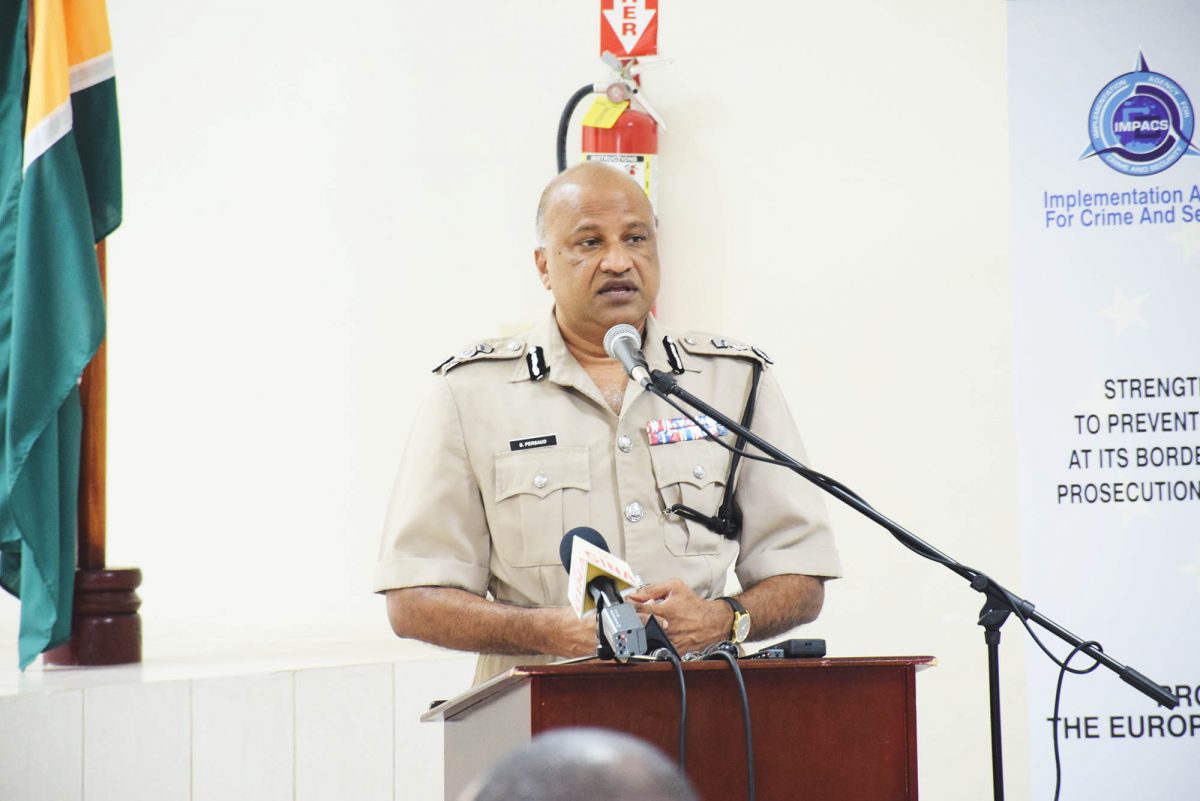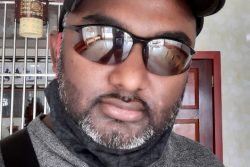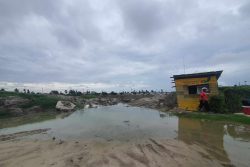In 2008, when he was Crime Chief, former Commissioner of police Seelall Persaud journeyed to the dangerous terrain of Christmas Falls, Upper Berbice River with other officers in an effort to dismantle the notorious Rondel ‘Fineman’ Rawlins gang, which was responsible for several heinous crimes.
Persaud, who chronicles his journey to the area in his recently published book ‘Stepping out of the Herd: My Life in the Guyana Police’ in a chapter titled Addressing National Security Issues, reveals that information came from a source named ‘Kofy’ and the police had the support of businessmen, some of whom hunted in the area.
Persaud’s book, written following his retirement in 2018, is the first by a former head of the Guyana Police Force.

The chapter also speaks about 14-year-old Dewayne Williams, who was arrested on the Ituni trail, and who, according to Persaud, gave the police valuable information about Rawlins and his gang being responsible for the massacres in Lusignan, Bartica and Lindo Creek, which saw some 31 people, including children, killed.
Williams, who is about 28 today, remains in protective custody and according to Persaud, has received support to develop himself even as efforts continue to have him reintegrated into society. He said he continues to give support to Williams.
Persaud wrote that Williams had informed the police that he was present when eight miners were tied up and killed by Rawlins and another man at Lindo Creek. However, this has been heavily disputed by family members and others who alleged that members of the Joint Services were responsible.
In 2018, then president David Granger had appointed a Commission of Inquiry (COI) to delve into the killings of Cecil Arokium, Dax Arokium, Horace Drakes, Bonny Harry, Lancelot Lee, Compton Speirs, Nigel Torres and Clifton Berry Wong on or around June 21, 2008. The men’s burnt remains were discovered by Dax Arokium’s father Leonard Arokium, who owned the mining camp.
Retired judge Donald Trotman headed the commission, which was widely criticised as a waste of time and resources (it cost $100 million). The report, handed over to Granger, had reportedly recommended, among other things, that the families of slain miners receive compensation. The findings were never made public, nor were the families compensated.
Trotman had also reportedly recommended that some parts of the investigation be reopened, noting that no one had been found culpable, and that senior security officials be called upon to explain their conduct during that period.
Granger had said that the report raised “troubling questions” about the roles of the police and defence force as well as the reticence of the political administration of the day to provide useful evidence to the commission.
Dismantling the Buxton Gang
Persaud said when he was appointed Crime Chief he made it his mission to dismantle the notorious Buxton Gang, which in 2006 was headed by Rawlins but had started with Dale Moore, Andrew Douglas, Troy Dick, Mark Fraser and Shawn Brown, who had shot their way out of the Camp Street Prison on Mash Day, February 23, 2002 and hidden in the Buxton backdam.
He wrote about setting up the ‘Major Crimes Investigations Unit,’ whose members were specially picked; it was headed by Detective Inspector Troy Reid. He had engaged present Crime Chief Wendell Blanhum, who was then a superintendent, to develop and take over the Crime Intelligence Unit.
Because he was crime chief, Persaud wrote, he could not engage with ‘Kofy’ his source any longer, and instead handed him over to then assistant superintendent Ravindra Budram (now Senior Super-intendent) to liaise after ‘Kofy’ agreed.
The former commissioner wrote about engaging with a known drug dealer he called ‘Brich’. Persaud wrote about ‘Brich’ as having taken over the drug scene following Roger Khan’s arrest and eventual conviction in the US. ‘Brich’, he wrote, had been kidnapped in 2002.
The description matches Bramanand Nandalall/Rambrichie, called ‘Bramma,’ who was kidnapped on October 28, 2002 reportedly by the Mash Day escapees. ‘Bramma’ later escaped and his flight triggered a series of killings. Michael Singh, 28, a US citizen, who was his guard, was found executed in Le Repentir Cemetery. Escapee Dale Moore and another man were shot dead in Lamaha Gardens. Businessmen Frank Solomon and Lancelot Roach and escapee Mark Fraser were gunned down on the East Coast Demerara. Fraser and Roach were in the latter’s car. Over the years, arrest warrants were issued for ‘Bramma’, but he was never charged.
According to Persaud, in 2007 ‘Brich’s’ status in “the world of organised crime in Guyana had dropped but [he] was regaining some prominence”. At that time, a businessman friend of Persaud’s had indicated that ‘Brich’ wanted to meet him.
“I decided to meet with him, but I was not prepared to be used by him to get rid of his rivals. On the contrary, I was prepared to use his cooperation to dismantle the Buxton Gang. I had also decided that in the event of the latter, his cooperation would be limited to providing information only,” Persaud wrote.
He also indicated that while he embraced the concept of civilian members of the community assisting the police in overt operations, he did not see a role for criminal elements (particularly those involved in organised crime).
Prior to his arrest, Khan was said to have been operating a Phantom Squad, which he claimed was assisting the police; the squad targeted his rivals, resulting in many bloodbaths. During this period, men in ski masks were seen in police operations or at crime scenes and were believed to be members of that squad. Reports were that then Home Affairs minister Ronald Gajraj sanctioned the squad. Gajraj, who is now deceased, had denied the claims and an investigation was launched. He was later cleared by an inquiry but international pressure on the government saw him being posted to India as High Commissioner. Khan had also used a ‘spy machine’ to intercept calls of persons and a 2002 letter sent to an official of the Miami-based Spy Shop purportedly by then Health Minister Dr Leslie Ramsammy confirmed support for the purchase of a “cell phone interceptor and geographic integrator” on behalf of the Government of Guyana. During Khan’s trial in the US, evidence of Ramsammy’s link was given but he has repeatedly denied every signing such a letter or knowing Khan.
Persaud said when they met, ‘Brich’ indicated that Rawlins had assisted him when he was kidnapped and therefore he would not contribute to targeting him. Persaud said he told ‘Brich’ they would stay in contact in the event he changed his mind.
They met again on October 1, 2010 when Mark Caesar, aka ‘Lil Mark,’ was killed in a drive-by shooting on Broad Street, Charlestown. Caesar’s killing was believed to be in retaliation for the killings of Steve Jupiter aka ‘Steve Man’, his reputed wife and three-year-old son; Christopher Gordon aka ‘Bigga’; and Sherwayne Jerome aka ‘Dice Head’. They had been driving through Cummings Lodge in September 2010, when gunmen opened fire on the car they were in. Jupiter, who was the target, had reportedly stolen the drugs Caesar gave him to transport but claimed the authorities seized them. His story was not believed and his killing was ordered by the owner of the drugs.
Persaud, was also head of the police narcotics branch at one point and held the post for some ten years. During that time it was believed that ‘Brich’ was connected to the murder of police Detective Cummings and Persaud said that following Caesar’s killing he instructed that all known and suspected major drug traffickers be questioned; wanted bulletins were therefore issued. The murder of Cummings was reportedly because he had received payment to return seized cocaine but instead demanded more money. There was no evidence, according to Persaud, to charge ‘Brich’.
After he was arrested in 2008 ‘Brich’ had complained to Persaud when they met that a wanted bulletin was issued when the police had not checked his home for him.
Persaud said he told ‘Brich’ that the killing of Jupiter and others had caused the nation fear and flashbacks of the crime spree and that he was complaining about the police’s legitimate efforts to bring an end to the mayhem.
“I also told him, as well as the others from the group of major/suspected major drug traffickers arrested during the investigations, that they now have a responsibility to bring the killings to an end. I explained that the killings, as well as the high impact police operation that would likely continue to be mobilized, could have consequences for their families as well, since they live in the same society. The police operation had its desired impact in that there were no other retaliatory killings, and information received from some of the interviews fueled investigations that led to the prosecution of Dexter Marshall for the murder of Mark Caesar,” Persaud wrote.
Persaud also wrote about the alleged kidnapping of Rawlins’s pregnant girlfriend Tanisha Morgan, who disappeared when she left for the hospital to deliver her baby. The police investigation went nowhere, but Persaud’s source ‘Kofy’ said that Morgan’s family had decided to take her away to safety.
Rawlins had reportedly promised to unleash havoc if Morgan was not returned and the massacres followed. According to Persaud, information provided by ‘Kofy’ and others indicated that the gang was being supported by political elements. Further information was provided by Durwain Wright, who was arrested and agreed to cooperate and give information on the gang after a deal was worked out with the Office of the Director of Public Prosecutions.
Wright was charged with murder on February 26, 2008 and remanded to prison, but as was arranged, was kept in police custody. Shortly after, several members of the Buxton Gang were arrested and charged with, among others, the Lusignan and Bartica murders.
Christmas Falls operation
According to Persaud, early in June 2008 they received information that Rawlins and four others were at a logging camp at Christmas Falls, 330 miles up the Berbice River. They were given a map on which the camp’s location was marked.
Persaud said he decided to do what no other crime chief had done and lead the team into the area.
He met with a businessman who introduced him to some associates who hunted in the area and he requested their
assistance without revealing specifics. He also got help from another businessman who equipped two police trucks with special tyres for mud trails and installed a winch on one of them. A boat with an engine and a trailer were borrowed from another businessman.
During the journey, Persaud contacted then head of the Tactical Services Unit and now acting police commissioner Clifton Hicken, who was heading an operation in Kwakwani at the time and he joined them.
Arriving at the location, they found that they were separated from the camp by a river. Hicken and the others went over, while Persaud remained behind in case the targets crossed the river during Hicken’s operation.
Persaud said he heard gunfire and several minutes later, the businessman who had transported Hicken and his team, returned for Persaud.
“I was surprised to find the camp was actually a wooden house built with a zinc roof on six-foot wooden stilts. A part of the bottom was enclosed and used as a kitchen,” Persaud wrote.
Hicken reported to him that the men saw them approaching and started shooting, they returned fire and one man, later identified as 19-year-old Otis Fifee aka ‘Mud-up’ of Buxton, was killed while four others escaped into the jungle. In the camp they found in excess of 3,000 rounds of ammunition used in AK-47 rifles and several firearms that had been stolen from the Bartica Police Station during the massacre. After communicating with then commissioner Henry Greene, he said, they decided that members of the Joint Services would pursue the four, who only had their rifles and the clothes they were wearing, while they returned to the city. Before leaving they burned the camp to deny the gang access to it.
During the Joint Services’ pursuit, a boat capsized delaying them. They then learned that on June 16, 2008 Rawlins and others had hijacked a bus and ordered the driver to take them to ‘Goat Farm’. The Joint Services followed that lead and in a confrontation with the men killed Robin Chung called ‘Chung Boy’ and ‘Uncle Willie’. Rawlins escaped. Two AK-47s and a quantity of ammunition were recovered from the scene. Two bank cards belonging to murdered agriculture minister Satyadeow Sawh were recovered from ‘Uncle Willie’s’ pocket.
“It is believed that he kept them as trophies. The finding of property of the late Mr Sawh in possession of Uncle Willie also provided more evidence on who was responsible for the murder of Mr Sawh, his relatives and his security guard,” Persaud wrote.
‘Small Friend’
According to Persaud, on June 16, 2008, 14-year-old Dwayne Williams was arrested at Ituni. The driver of a motor lorry had become suspicious when Williams, who was a stranger to the area, asked him for a ride, and had taken him to the police station instead. Williams was transferred to Georgetown and his mother was contacted. On her urging, during the interview, he admitted to being at all three of the massacres, according to Persaud.
Williams and his siblings had moved with their mother to Buxton from Canal Number One. He was in primary school at the time of the 2002 escape. He remembered seeing the gang in the village. He said in January 2008 when a GDF soldier was killed by bandits in Buxton, he was right there. They ran into the backdam as they expected the joint services would have responded in great numbers and he ran with them with them and stayed.
He gave names of gang members who were in the backdam and related that the gang was supported by some people and that shop owners gave them rations, some out of fear, others hoping that when they got money through robberies they would pay.
Williams also said that sometime after the Lusignan massacre they left the area and walked to the Nabaclis foreshore where they boarded a boat. That was in February. The boat was operated by Clebert Reece aka ‘Chi’. They were then joined by Mark Royden Williams aka ‘Smallie’ (who was acquitted for the Lusignan massacre but sentenced to death for the Bartica massacre), his cousin Dennis Williams aka Anaconda (also sentenced to death for the Bartica massacre), and Michael Caesar called ‘Capone’ (sentenced to 60 years in prison for the Bartica massacre). They later picked up a fair-skinned man they called ‘White Boy’.
After the massacre and robberies at Bartica, Williams told the police, they drove the boat to another location and left it to drift. The boat was found by the police and the engine was traced to a businessman who said he had loaned it to a fisherman who could not be found.
According to Williams, on leaving the boat, they walked on a trail until they reached a vehicle which had the key in the ignition, and they then drove in the direction of Linden. The vehicle later got stuck in mud, but a man arrived and drove them to the outskirts of Linden.
They bought food, Williams told the police, adding that Rawlins had three Ovaltine tins full of stolen gold which he shared among them. Williams said he was told his portion was valued $3 million. Each of them was then asked to give one-third of their portion to ‘White Boy’ who would go to Venezuela to buy new firearms for them. They complied and it was the last time they saw ‘White Boy’.
After the confrontation at Christmas Falls, Williams said, four of them walked in the jungle for days and later built a raft and crossed the Berbice River. They then walked in the jungle again and happened on fuel drums on the trail, which ‘Uncle Willie’ said were placed there by miners to indicate they needed fuel. They therefore started to search for the mining camp and that night saw two men with flashlights and demanded that they take them to the camp. This was Lindo Creek. There, the miners cooked for them and they stayed.
The next night, Williams said, he was awakened by gunshots and saw ‘Uncle Willie’ and Rawlins shooting the miners, who had their hands tied behind their backs. “When they were finished, one of the miners was still moving, and Uncle Willie took a hammer and hit him behind his head,” Persaud wrote about Williams’ account. He said Rawlins told him and ‘Chung Boy’ that they could not trust anyone. The men’s bodies were then heaped together on some branches and burnt and they left for Kwakwani.
Williams said he became dehydrated and lagged behind and the three left him. He hid his gun and decided to seek help, but the lorry driver took him to the police, whom he later took to the spot where he had hidden the gun.
A few days later the burnt remains of the miners were found at Lindo Creek.
Persaud said he found it surprising that the COI did not find it useful to have Williams testify even though he was the lone survivor and had a written statement outlining his account of the incident.
The end of Fineman
On August 29, 2008 Fineman Rawlins and Jermaine `Skinny’ Charles were killed following an almost seven-hour operation, which started at Timehri. Another man, identified as Seon Grant of Timehri Squatting Area, was also killed in the process. The two were eventually shot in an unfinished concrete structure in Kuru Kururu at a place the villagers call Kakabura.
Rawlins had been notorious for five years; police had first published a wanted bulletin for him in June 2003. Police had said he was the leader of the Agricola/Buxton criminal gang. Born and raised in Agricola, East Bank Demerara, he was still in his early 20s when that bulletin was published. Not much is known about his schooling and childhood days.







